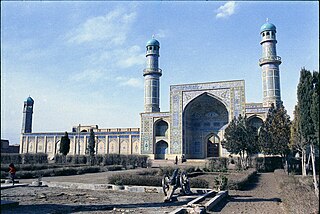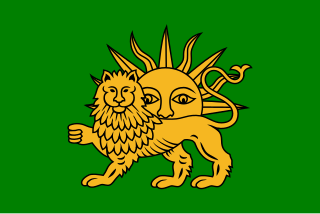Related Research Articles

Herāt is an oasis city and the third-largest city in Afghanistan. In 2020, it had an estimated population of 574,276, and serves as the capital of Herat Province, situated south of the Paropamisus Mountains in the fertile valley of the Hari River in the western part of the country. An ancient civilization on the Silk Road between West, Central and South Asia, it serves as a regional hub in the country's west.

The Safavid dynasty was one of Iran's most significant ruling dynasties reigning from 1501 to 1736. Their rule is often considered the beginning of modern Iranian history, as well as one of the gunpowder empires. The Safavid Shāh Ismā'īl I established the Twelver denomination of Shīʿa Islam as the official religion of the Persian Empire, marking one of the most important turning points in the history of Islam. The Safavid dynasty had its origin in the Safavid order of Sufism, which was established in the city of Ardabil in the Iranian Azerbaijan region. It was an Iranian dynasty of Kurdish origin, but during their rule they intermarried with Turkoman, Georgian, Circassian, and Pontic Greek dignitaries, nevertheless, for practical purposes, they were Turkish-speaking and Turkified. From their base in Ardabil, the Safavids established control over parts of Greater Iran and reasserted the Iranian identity of the region, thus becoming the first native dynasty since the Sasanian Empire to establish a national state officially known as Iran.

Gilan province is one of the 31 provinces of Iran, in the northwest of the country. Its capital is the city of Rasht. The province lies along the Caspian Sea, in Iran's Region 3, west of the province of Mazandaran, east of the province of Ardabil, and north of the provinces of Zanjan and Qazvin. It borders Azerbaijan in the north.

Abbas I, commonly known as Abbas the Great, was the fifth shah of Safavid Iran from 1588 to 1629. The third son of Shah Mohammad Khodabanda, he is generally considered one of the greatest rulers of Iranian history and the Safavid dynasty.

Tahmasp I was the second shah of Safavid Iran from 1524 until his death in 1576. He was the eldest son of Shah Ismail I and his principal consort, Tajlu Khanum.

Ismail I was the founder and first shah of Safavid Iran, ruling from 1501 until his death in 1524. His reign is often considered the beginning of modern Iranian history, as well as one of the gunpowder empires. The rule of Ismail I is one of the most vital in the history of Iran. Before his accession in 1501, Iran, since its conquest by the Arabs eight-and-a-half centuries earlier, had not existed as a unified country under native Iranian rule. Although many Iranian dynasties rose to power amidst this whole period, it was only under the Buyids that a vast part of Iran properly returned to Iranian rule (945–1055).

The Hotak dynasty was an Afghan monarchy founded by Ghilji Pashtuns that briefly ruled portions of Iran and Afghanistan during the 1720s. It was established in April 1709 by Mirwais Hotak, who led a successful rebellion against the declining Persian Safavid empire in the region of Loy Kandahar in what is now southern Afghanistan.

Talysh Khanate or Talish Khanate was an Iranian khanate of Iranian origin that was established in Afsharid Persia and existed from the middle of the 18th century till the beginning of the 19th century, located in the south-west coast of the Caspian Sea.

The Shamlu tribe, also known as the Shamli tribe, was one of the seven original and the most powerful Qizilbash tribes of Turcoman origin in Iran.
Iran and Georgia have had relations for thousands of years. Eastern and Southern Georgia had been under intermittent Persian suzerainty for many centuries up to the early course of the 19th century, while western Georgia had been under its suzerainty for much shorter periods of time throughout history. Georgia especially rose to importance from the time of the Persian Safavids.

Gīlān is an Iranian province at the southwestern coast of the Caspian Sea. This articles discusses its history.

Safavid Iran or Safavid Persia, also referred to as the Safavid Empire, was one of the largest and long-standing Iranian empires after the 7th-century Muslim conquest of Persia, which was ruled from 1501 to 1736 by the Safavid dynasty. It is often considered the beginning of modern Iranian history, as well as one of the gunpowder empires. The Safavid Shāh Ismā'īl I established the Twelver denomination of Shīʿa Islam as the official religion of the empire, marking one of the most important turning points in the history of Islam.

The Kar-Kiya dynasty, also known as the Kiya'ids, was a local Zaydi dynasty which mainly ruled over Biya-pish from the 1370s to 1592.
Khan Ahmad Khan, was the last king of the Karkiya dynasty in Gilan, ruling from 1538 to 1592. In 1591, the Safavid shah Shah Abbas asked Khan Ahmad Khan's daughter Yakhan Begum to marry his son Mohammad Baqer Mirza, since Khan Ahmad Khan had no male successor. Khan Ahmad Khan disagreed due to the age of his daughter. This and some other economic factors caused a Safavid raid in 1591 and Khan Ahmad Khan escaped to Ottoman territories, and spent the rest of his life in Constantinople and Baghdad, spending fruitless attempts to return to power. He died in 1596 and was buried in Najaf, one of the holiest cities of Shia Islam.
Farhād Khān Qarāmānlu, also known by his honorific title of Rokn al-Saltana, was a Turkoman military officer from the Qaramanlu family, and was the last member of the Qizilbash to serve as commander-in-chief (sipah-salar) of the Safavid Empire.
The Military of Safavid Iran covers the military history of Safavid Iran from 1501 to 1736.
Mehdi Qoli Khan Shamlu was a Turkoman military officer from the Shamlu tribe, who briefly served as the Safavid governor of Bia-pish from 1592 to 1593.
Bahram Mirza Safavi was a Safavid prince, governor and military commander in 16th-century Iran. He was the youngest son of Shah Ismail I, the founder of the Safavid dynasty.
Tālīsh is a region in the southwestern coast of the Caspian Sea. It is a homeland of the indigenous Talysh people, who inhabit the region and speak the Talysh language. The territory and the language set apart Talish from its neighbors.

The region of Talish was a governorate of Safavid Iran (1501–1736), located in the greater Talish, presently divided between Iran and Azerbaijan. The territory of the governorate was principally made up of the two subordinate governorates of Astara and Lankaran. The city of Astara was its administrative center, the base of Safavid power in the region.
References
- ↑ Dehkhoda, Aliakbar. "Biah Pish". Vajehyab (in Persian). Retrieved 17 November 2016.
- ↑ "Khan Ahmad ambassador to Tezar". Lahig (in Persian). 2011. Retrieved 17 November 2016.